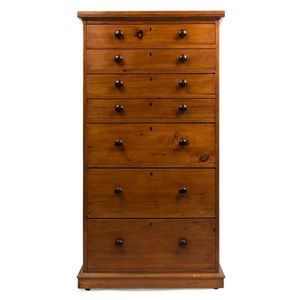Unusual Colonial Campaign Chest with German Influence
You must be a subscriber, and be logged in to view price and dealer details.
Subscribe Now to view actual auction price for this item
When you subscribe, you have the option of setting the currency in which to display prices to $Au, $US, $NZ or Stg.
- Campaign Furniture - Most of the campaign furniture on the market is associated with the time of the British Empire in the 18th and 19th centuries when there was a high demand from military officers, administrators and colonists.
Campaign furniture is demountable, through clever use of wooden screws and sometimes metal hinges, so that it can disassembled and then packed into lots of manageable size for ease of movement by ship or animal between postings or camps. - Reeding - A series of parallel, raised convex mouldings or bands, in section resembling a series of the letter 'm'. The opposite form of fluting, with which it is sometimes combined. Reeding is commonly found on chair legs, either turned or straight, on the arms and backs of chairs and couches and around table edges in the Neoclassical or Classical Revival manner. Reeding was also used as a form of decoration during the Edwardian period, but it is usually much shallower and evidently machine made.
- Bramah Locks - A patented high security high quality lock, invented in 1784 by Joseph Bramah, and designed a lock mechanism operated by a tubular key, of such complexity and security, that he put it in his shop window and offered a reward of 200 guineas to anyone who could open it. In 1787 Joseph Bramah?s lock patent was granted with 479,001,600 keys required to open it under all its variations.
Genuine Bramah locks are stamped with the makers name on the top face of the lock, and are easily recognisable because the circular brass barrel of the lock, also forms the escutcheon, and protrudes front the front to which it is fitted.
Bramah locks were used by the best furniture makers of the period, such as Gillows, most commonly from about 1820 onwards, the use of the lock being restricted presumably due to their cost. If an item of furniture is fitted with a Bramah lock, it is generally an indication it is a quality piece. - Column - An architectural feature sometimes used for decorative effect and sometimes as part of the supporting construction. Columns should generally taper slightly towards the top. They may be plain or decorated with carving, fluting or reeding. Columns may be fully rounded or, more commonly, half-rounded and attached with glue, screws or pins to the outer stiles of doors, or the facing uprights on cabinets and bureaux.
- Kauri - An evergreen conifer tree associated with New Zealand, but also grown in northern Australia, and islands around the Pacific rim including Borneo, Vanuatu and New Guinea. The timber is generally golden in colour, and straight grained without much knotting.
A by-product of the kauri tree was the kauri gum, the fossilised resin extracted from the tree. The gum was obtained through digging, fossicking in treetops, or more drastically, by bleeding live trees. Kauri gum was used in the manufacture of varnishes and other resin-based products, and also crafted into jewellery, keepsakes, and small decorative items.
Kauri forests were prolific in the north of the North Island of New Zealand. European settlers in the 1700 and 1800s realised that the timber from these tall trees with broad trunks would be ideal for ship building and construction and a thriving industry was established harvesting the kauri tree. The forests were substantially reduced, and now the remaining Kauri trees that grow in New Zealand are protected, and there are reserves in various areas of the North Island.
The remaining stands of kauri in New Zealand are under threat from "kauri disease", a microscopic organism that causes dieback in the trees, with vast tracts either dead or dying. - Escutcheons - An escutcheon is a plate, made of brass, wood, ivory or ebony, which fits into or over the h keyhole, to protect the edge of the timber keyhole from damage by continual insertions of the key. As a general rule you would expect these escutcheons to be sympathetic in design to the handles of the piece. From the early 19th century escutcheons were sometimes made from ivory, ebony, bone or contrasting wood, often cut in a diamond or shield shape and inlaid into the front. Ivory, in particular, will tend to discolour with age, and certainly should not show up as brilliantly white.
This item has been included into following indexes:
- Bramah & Co. (Britain) - furniture locks 10
- chests of drawers, material - kauri 71
-
chests of drawers, style
- campaign and military 130
- five drawer 286
Visually similar items

A George III mahogany chest on chest, the upper section with square fret pediment, blind fret cornice, five cock-bead edged drawers with attractive cast brass bale handles and Rococo escutcheons, flanked by fluted canted corners, the lower section with a b

A 19th century English mahogany chest on chest the base with three drawers on bracket feet, the upper section with five drawers and dentil moulded pediment, brass swan necked handles. Some old restorations. Height 286 cm. Width 114 cm. Depth 58 cm

Georgian mahogany chest on chest c. 1780 moulded cornice above two short and six long graduated drawers, with brass handles and escutcheons. Height 199 cm

A Colonial tallboy chest of seven drawers, kauri pine, huon pine and blackwood, 19th century 140 cm high, 73 cm wide, 48 cm deep
